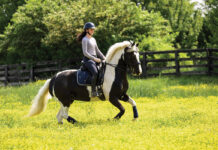 |
June Evers, author of The Ultimate Guide to Horse Treats, shares two of her favorite recipes. Also, Carey Williams, Ph.D., Rutgers University equine extension specialist provides some practical tips for horse health while feeding special treats.
“While I know (the horses) don’t know it’s a special time of year—every day is special for them—it sure makes me feel good to prepare these treats. It’s especially fun if you have an old silver platter and walk down the aisle in the barn serving off the silver platter,” says Evers.
Nutritional Sense
When making your own equine treats, Williams cautions to be aware of potentially toxic ingredients, such as St. John’s Wort, tomatoes, chestnuts and bull or horse nettle. If you compete, you should also steer clear from ingredients such as valerian, poppy seeds, licorice, and cocoa or tea leaves, which could potentially test positive for drugs.
If your horse has special dietary concerns, remember that, too, as you prepare treats.
“Cushing’s, laminitis or Polysaccharide Storage Myopathy (PSSM) prone horses cannot have any sugar or molasses, similar to a diabetic human,” Williams explains. “And Quarter Horses with Hyperkalemic Periodic Paralysis cannot have feeds high in potassium, such as bananas.”
With these cautionary tips in mind, head to the kitchen and try mixing up some of the tasty treats below.
Recipes
Carrot & Apple Pâté with Faux Caviar
Ingredients:
2 carrots, diced
1 medium apple, sliced
1/3 cup honey (or molasses)
1/3 cup bran
1/4 cup water
Hay cubes
Handful of horse feed pellets
Handful of raisins
Preparation:
Place apples, honey (or molasses), bran and water into a blender. Add carrots slowly and blend until pureed. Mixture should be pasty; add more bran if necessary. Spread liberally onto each hay cube and top with one raisin and a sprinkle of pellets (the “faux caviar”).
Tri-Color Apple & Carrot Salad
Ingredients:
1 large handful of hay
1 to 2 carrots with the tops, sliced
2 red apples, cut in sixths
2 green apples, cut in sixths
2 yellow apples, cut in sixths
Preparation:
Straighten out hay and cut with scissors into pieces approximately 10 inches long and place in a feed bucket. Arrange in a criss-cross pattern, making a circle flat on the bottom of the feed bucket. Cut the tops off the carrots and tuck the green tops in around the edge of the criss-crossed hay.
Arrange sliced carrots and the apples in a decorative manner, alternating the colors of the apples. To garnish: Place a sprig of carrot top in the center of the salad.
These recipes are excerpted from The Original Book of Horse Treats by June Evers, www.horsehollowpress.com
See more recipes for homemade horse treats >>






Horse treats are a good idea for christmas gifts around the barn, especially home made ones cut into christmas or horsey shapes.
the book is great I have it
I just went for a search on horse homemade treats and found garlic in some receips, after checking what garlic does for your horse i was supprised to find a site on a study on giving garlic to your horse
Recent Research Showing the Effects of Garlic on Horses
A study published in the March 2005 issue of the American Journal of Veterinary Research, conducted by the Department of Animal and Poultry Science at the University of Guelph in Canada concluded:
Horses will voluntarily consume sufficient quantities of garlic to cause Heinz body anemia. The potential for garlic toxicosis exists when horses are chronically fed garlic.
In this study horses were fed freeze-dried garlic at a maximum amount of .25 grams per kilo of body weight for 71 days–less than three months. Researchers observed pathological changes in the blood when garlic was fed at an amount of .2 grams per kilo of body weight. For those of us who use pounds and ounces that’s about 3.2 ounces of freeze-dried garlic a day for a 1000 pound horse. They continued to take blood samples from the horses for five weeks after garlic supplementation was discontinued. Although the results of the blood tests improved at the end of 5 weeks, at which point the study was concluded, aberrations in the blood were still visible five weeks after garlic supplementation was stopped. To read more about this paper or obtain a copy of it follow this link: garlic horses
I make a carrot/apple treat up for my horses, but treats are just that…treats, not to be fed all the time.
Looks like fun!